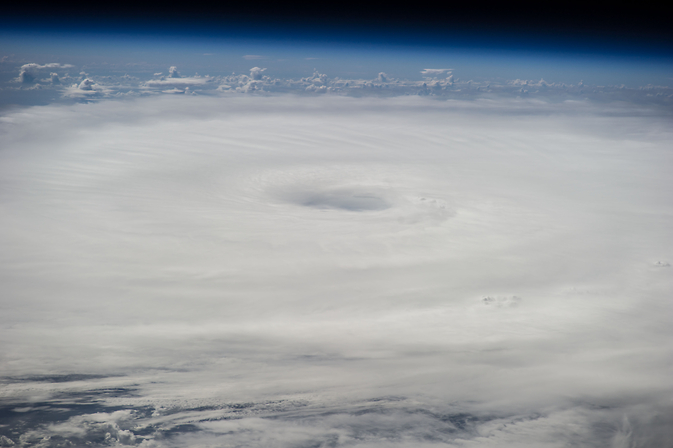NASA Sees Hurricane Edouard Far From U.S., But Creating Rough Surf

This photograph of Hurricane Edouard was taken from the International Space Station on Sept. 17, 2014. Image Credit: NASA JSC/ISS
On Sept. 17, the National Hurricane Center noted “Swells from Edouard will affect portions of the east coast of the United States north of Florida beginning today. These swells will likely cause life-threatening rip current conditions along most of the United States east coast for the next couple of days.”
When NASA's Aqua satellite passed over Hurricane Edouard on Sept. 16 the MODIS instrument captured a visible image of the storm that it still maintained its eye. Bands of powerful thunderstorms were spinning into the center from the north and south.
At 11 a.m. EDT on Sept. 17, Edouard's maximum sustained winds were near 90 mph (150 kph) and weakening is forecast. The eye of Hurricane Edouard was located near latitude 36.4 north and longitude 53.3 west. Edouard is moving toward the northeast near 24 mph (39 kph) and turn east on Sept. 18. The latest minimum central pressure reported by a NOAA Hurricane Hunter aircraft is 958 millibars.
The National Hurricane Center expects rapid weakening on Sept. 18 with Edouard dropping in intensity to a tropical storm.
Rob Gutro
NASA's Goddard Space Flight Center
Media Contact
More Information:
http://www.nasa.gov/content/goddard/td6-atlantic-ocean/All latest news from the category: Earth Sciences
Earth Sciences (also referred to as Geosciences), which deals with basic issues surrounding our planet, plays a vital role in the area of energy and raw materials supply.
Earth Sciences comprises subjects such as geology, geography, geological informatics, paleontology, mineralogy, petrography, crystallography, geophysics, geodesy, glaciology, cartography, photogrammetry, meteorology and seismology, early-warning systems, earthquake research and polar research.
Newest articles

High-energy-density aqueous battery based on halogen multi-electron transfer
Traditional non-aqueous lithium-ion batteries have a high energy density, but their safety is compromised due to the flammable organic electrolytes they utilize. Aqueous batteries use water as the solvent for…

First-ever combined heart pump and pig kidney transplant
…gives new hope to patient with terminal illness. Surgeons at NYU Langone Health performed the first-ever combined mechanical heart pump and gene-edited pig kidney transplant surgery in a 54-year-old woman…

Biophysics: Testing how well biomarkers work
LMU researchers have developed a method to determine how reliably target proteins can be labeled using super-resolution fluorescence microscopy. Modern microscopy techniques make it possible to examine the inner workings…





















